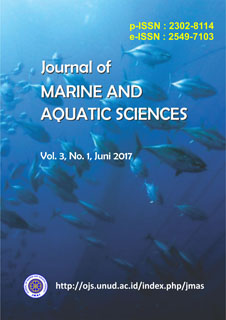Peranan Padang Lamun Selatan Bali Sebagai Pendukung Kelimpahan Ikan di Perairan Bali
Abstract
Seagrass ecosystem is providing feeding ground, nursery ground, spawning ground , habitat and shelter area. The threat of physical destruction such as the reclamation, pollution, sedimentation and tourism activities decreasing the diversity and the abundance of fishery commodities. The purpose of this study was to describe the condition of seagrass, determine the composition and abundance of seagrass fish in the three Southern coast of Bali and assess the association of fish-sea grass. Samples were taken from three coastal areas, Samuh, Shindu and Serangan coastal area. The results are in Samuhthere are 6 types of seagrass, in Shindu there are 7 types and in Serangan there are three types, whichdominates with Cymodocea rotundata and Syringodium isoetifolium. From the three coastal areas,we found 21 families of fish, where the family Pomacentridaehas the highest species abundance in Samuh, Apogon sp in Serangan and Terapon sp. found in Shindu. We can see the interaction between the seagrass ecosystems of coral reefs in the waters of South Bali and ecological role of seagrass from the family and species of fish.Downloads
Download data is not yet available.
Published
2017-02-01
How to Cite
FAIQOH, Elok; WIYANTO, Dwi Budi; ASTRAWAN, I Gede Budi.
Peranan Padang Lamun Selatan Bali Sebagai Pendukung Kelimpahan Ikan di Perairan Bali.
Journal of Marine and Aquatic Sciences, [S.l.], v. 3, n. 1, p. 10-18, feb. 2017.
ISSN 2549-7103.
Available at: <https://ojs.unud.ac.id/index.php/jmas/article/view/27969>. Date accessed: 18 dec. 2025.
doi: https://doi.org/10.24843/jmas.2017.v3.i01.10-18.
Issue
Section
Articles
Keywords
seagrass role; fish; southern Bali

This work is licensed under a Creative Commons Attribution 3.0 International License.
Copyright 2012 - 2023 Journal of Marine and Aquatic Sciences (JMAS)
Published by Fakultas Kelautan dan Perikanan Universitas Udayana, Denpasar, Bali, Indonesia
JMAS (p-ISSN 2302-8114; e-ISSN 2549-7103)


